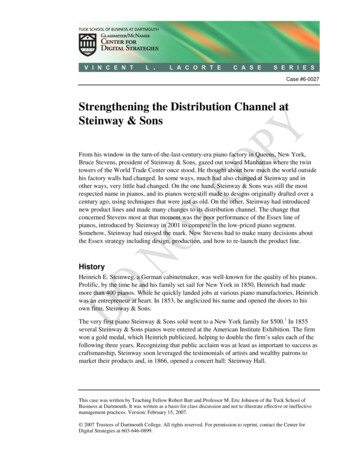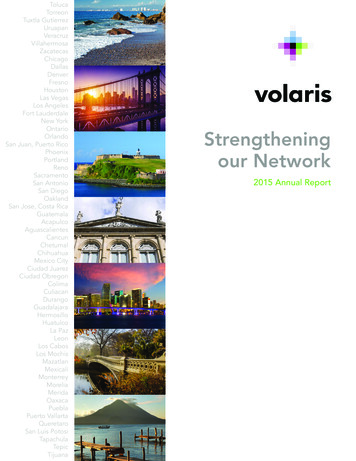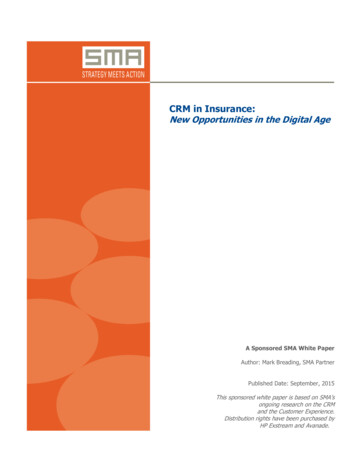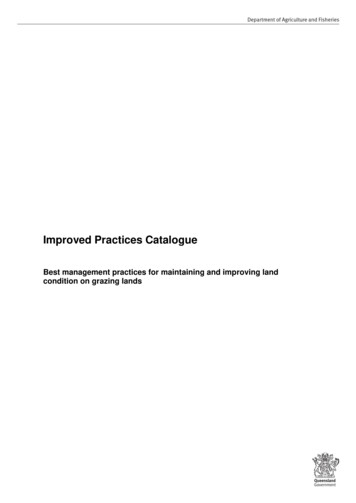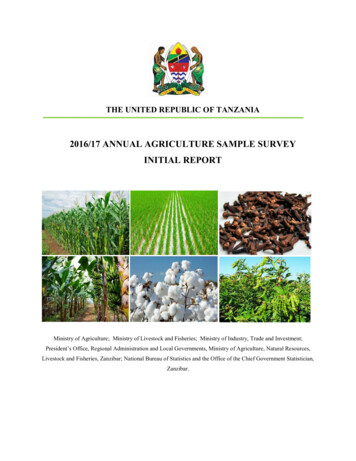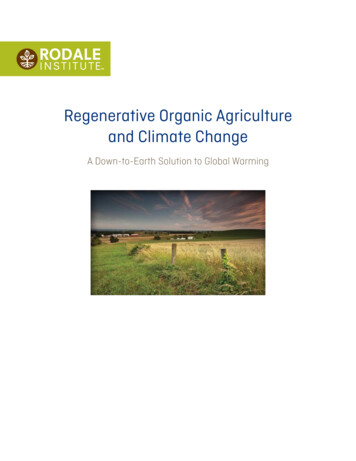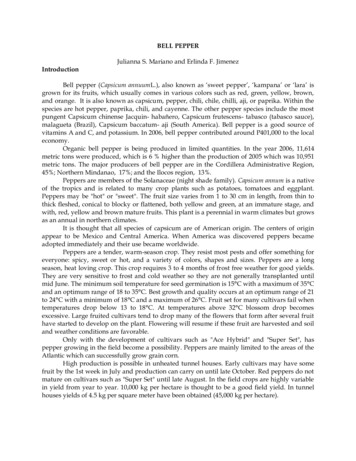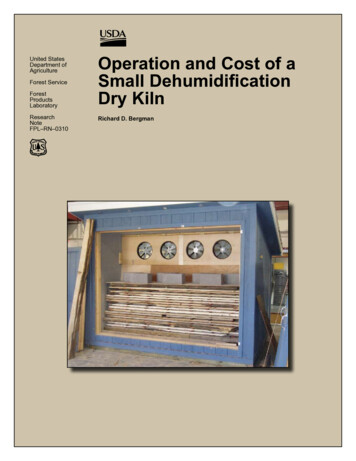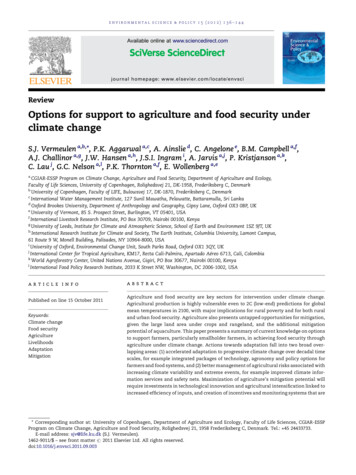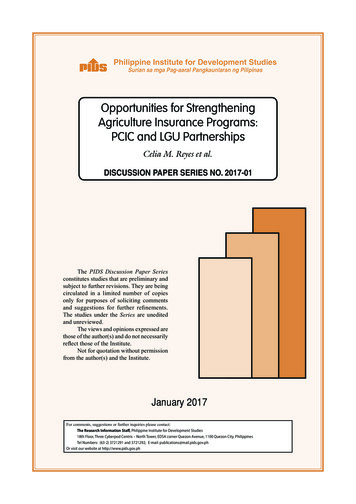
Transcription
Philippine Institute for Development StudiesSurian sa mga Pag-aaral Pangkaunlaran ng PilipinasOpportunities for StrengtheningAgriculture Insurance Programs:PCIC and LGU PartnershipsCelia M. Reyes et al.DISCUSSION PAPER SERIES NO. 2017-01The PIDS Discussion Paper Seriesconstitutes studies that are preliminary andsubject to further revisions. They are beingcirculated in a limited number of copiesonly for purposes of soliciting commentsand suggestions for further refinements.The studies under the Series are uneditedand unreviewed.The views and opinions expressed arethose of the author(s) and do not necessarilyreflect those of the Institute.Not for quotation without permissionfrom the author(s) and the Institute.January 2017For comments, suggestions or further inquiries please contact:The Research Information Staff, Philippine Institute for Development Studies18th Floor, Three Cyberpod Centris – North Tower, EDSA corner Quezon Avenue, 1100 Quezon City, PhilippinesTel Numbers: (63-2) 3721291 and 3721292; E-mail: publications@mail.pids.gov.phOr visit our website at http://www.pids.gov.ph
Opportunities for strengthening agriculture insurance programs: Philippine Crop InsuranceCorporation and LGU partnershipsCelia M. Reyes, Adrian D. Agbon, Christian D. Mina, and Reneli Ann B. Gloria 1AbstractProviding agriculture insurance to the farmers and fisher folks in thePhilippines has been implemented for nearly three decades. While it is agreedthat agricultural insurance is crucial in assisting farmers, fisher folks, andgovernments lessen the negative financial impact from natural events, issuesof providing premium subsidies and being tied to credit in the Philippinesremain to important policy issues. This paper reviews available informationabout partnerships between LGUs and the Philippine Crop InsuranceCorporation. The aim is to look at these innovations which may promote andenhance agricultural insurance in the Philippines. Providing for full premiumsubsidies and as a form of loan to the farmers was implemented by the LGUsreviewed in this paper. Further study is needed to determine which schemeworks best in terms of increasing coverage over the long-term and ensuringfinancial viability.Key words: agricultural insurance, LGUs, Philippine Crop Insurance, subsidy1IntroductionThe agriculture remains a source of livelihood for almost half of humanity. It is also a sourceof growth for national economies, and can be a provider of investment opportunities for theprivate sector. However, millions of poor people face prospects of tragic crop failure orlivestock mortality when, as a result of climate change, rainfall patterns shift or extremeevents such as drought and floods become more frequent. Agricultural insurance is crucialin assisting farmers, herders, and governments lessen the negative financial impact of theseadverse natural events (Mahul and Stutley, 2010).In the Philippines, the Philippine Crop Insurance Corporation (PCIC) implements thegovernment program on agricultural insurance. The scheme provides insurance protectionto agricultural producers against loss of crops, livestock and agricultural assets on account ofnatural calamities, plant pests and disease and/or other perils. More than this service,agricultural insurance is thought to have greater socio-economic relevance. The systemtargeted to address not only the welfare aspect of the after-loss event, but also help inachieving the objective of stabilizing farm incomes more equitably. It also aims to reversethe risk-averse nature of farmers and motivate them to invest more on new technologies tohelp increase productivity (Reyes and Domingo, 2009).Currently, only fourteen local government units across the country has an existingpartnership with PCIC (figure 1 below). A brief description of each of the fourteen LGUs aresummarized in table 1 with name of the program, priority crops, and indicative budget ofthe program. The research team was able to visit four LGUs which have current partnership1The authors are Senior Research Fellow of the Philippine Institute for Development Studies and Supervising Research Specialists. Theauthors gratefully acknowledge the research assistance of Ma. Blesila D. Mondez and Ronina D. Asis . Views expressed here are those ofthe authors and do not necessarily reflect those of the institutions they are a part of.
with PCIC. These are the Provincial governments of Isabela, Cebu, Negros Occidental andDavao del Norte. This paper draws insights from the focus group discussions and keyinformant interviews during the field visits. The main purpose of the regional visits were togain a better understanding of the implementation of the agricultural insurance programand gauge whether LGUs increase enrollment of farmers with crop insurance. In section 2,we discuss the programs of the four provincial governments in providing agriculturalinsurance in partnership with PCIC. Section 3 discusses the coverage rates, number ofenrolled farmers, and the matching exercise of the data sets from the PCIC, LGU, and theRSBSA. Section 4 explains free subsidy vis-a-vis cost-sharing subsidy and section 5 concludesthe paper.Figure 1 LGUs with current partnership with PCIC
Table 1 LGU Agriculture Insurance ProgramName of LGUsName of ProgramRate of SubsidyIsabelaVictoria , TarlacGuagua , PampangaSan Fernando , PampangaBRO - Paneguro sa PananimPalay Insurance CY 2013 and 2014Palay Insurance 2014Palay InsuranceADSS (CY 2014 & 2015)Corn ProductionFarmer and LI share onlyWet Season - 8.48%Wet Season - 8.48%Dry & Wet Season - 5.13%8.48%Phase A - 5.84%Phase B - 9.51%3.00%4.75%Lucena City , QuezonPalawanNegros OccidentalCapizGuimarasCebuBoholDavao del NorteAgusan del NorteCorn ProductionNegros First Universal CropInsurance (NFUCIP)Viable Insurance for CapizLGU DA GuimarasAgri Fishery Insurance ProgramRiceAcceleratedEngagementResponse (RACER),Rice Action Program for InstitutionalDev. (RAPID)Insurance coverage of Agri-FisheryProjects/ProgramsClimate Change Resiliency thru RiskTransfer Mechnism for ,000,000.005.94%5.94%Farmer and LI share onlyFarmer and LI share 050%1,034,000.00500,000.00Source: PCIC, 2015 Note: No information given for Camarines Sur2The PCIC LGU Partnerships2.1 Bojie-Rodito Opportunities – Paneguro sa Pananim (BRO–PSP) Program in IsabelaBackgroundDuring the administration of Governor Faustino G. Dy III and Vice Governor Rodolfo AlbanoIII, the provincial government of Isabela initiated the Bojie-Rodito Opportunities (BRO)program for agriculture. The program was created to provide support to small farmers whotill one hectare or less of land, and whose primary source of income is agriculture. Asidefrom helping farmers deal with financial difficulties, the program is intended to promoteeconomic independence and improve productivity (PIA, 2012) of the farmers in theprovince. The BRO program targets around 102,000 small rice and corn farmers to beprovided with crop insurance (RDC II, 2011). The program has ten subprograms that aid notonly through agricultural programs, but also through providing health benefits to theintended beneficiaries. Moreover, the BRO program includes loan assistance to marginalizedfarmers (BRO-LAMF), enrollment to Philhealth (BRO-PHM), and scholarships for the farmers'children (BRO-ED).As part of the BRO program, the Province of Isabela, in partnership with the PCIC, hasprovided full subsidies for the farmers’ premium share, particularly for rice and corn cropmulti-risk insurance through the Bojie-Rodito Opportunities-Paneguro sa Pananim (BROPSP) subprogram since the dry season of 2010. This program started first in fivemunicipalities, and was expanded across the province. The initial MOA for the program wassigned on September 2, 2010 at the Isabela Capitol.
ProcessThe main parties involved for the program in terms of identifying the potential beneficiariesare staff from the Isabela provincial government and from the local government units. Themunicipal agriculturists are required to provide a master list of small farmers to theprovincial government. Since the provincial government prioritizes farmers who need thefree insurance the most, the insurance applicants may in some cases be further verified byeither provincial government or LGU staff. The provincial government aims to offer theinsurance to all small farmers, thus making the program open to both new clients andrenewals. Farmers who are eligible for this program have rice and corn areas of 0.25 to onehectare. Also, eligible farmers for the insurance have either just planted or will be plantingin the next ten days. As part of the policy, after ten days from planting, the crops becomeineligible for insurance since the crops may have already been exposed to risks.Insurance applications may be accomplished in various ways. Generally, provincial staff maytransact directly with the farmers on the field, and LGU staff may perform the transactionsthen later forward the applications to the capitol for the more distant municipalities. Whilethere are sufficient staff on the field, staff are also available at the provincial office toaccommodate walk-in farmer clients. While the farmers are required to submitrequirements such as the application forms, farm plan and budget, and farm sketch, thelatter two requirements may be sourced from the LGUs’ respective Municipal AgriculturistOffices (MAO). Provincial staff or LGU staff may also assist the farmers in filling out theapplication forms. It is important to note that all applications are first submitted to theprovincial government, and the provincial government will be the one to forward thedocuments to PCIC RO II in Tuguegarao City. Downloaded funds to PCIC from the ProvincialGovernment are used to subsidize the premium, subject to the following rates;Table 2 Premium rate sharing for rice and corn (BRO-PSP)RiceWet season(May1October 31)CornDryseason PhaseA(November 1 - (April - June)April 30)PhaseB(September December)Provincial Government ofIsabelaGovernment 8.8519.61Upon approval, the farmers’ CICs will be forwarded back to the provincial government. TheCICs will then be forwarded to the municipalities, and copies of the CICs may be sent to thefarmers.Claims
Farmers have to file a notice of loss and have the LGU staff or to the provincial staff who willforward the forms to the PCIC regional office. Normally, adjusters arrive at the area withdamaged crops within two to three days of receipt of notice of loss. The checks forapproved claims payments are again forwarded from the PCIC to the provincial government,and the provincial government forwards the checks to the LGU staff to be distributed to thefarmers.The maximum amount for cover for corn is 10,000 pesos per hectare, while that for rice is12,000 pesos. In its first year, 3 million pesos was allocated to cover 7,000 farmers. Another9,000 farmers were also covered during the next three cropping seasons from an additional5 million pesos allocation. In 2012, subsidies reached a total of 10 million pesos; 7 millionpesos was allocated for the wet cropping season, while the remaining 3 million pesos wasused for the dry cropping season. From 2010 to 2012, there were about 3,137 farmers whowere able to receive claims payment, which translates to about 8.351 million pesos in termsof indemnity claims.Accident Insurance for Fisher folkAnother component of the BRO program provides fisher folk, particularly those in thecoastal municipalities of Isabela province is the accident insurance through the Accident andDismemberment Security Scheme (ADSS). Around 1,000 fisher folk (PCIC, 2011) were givenfree accident insurance with a 50 thousand pesos cover for a year. Unlike the crop insuranceprogram wherein funds are downloaded, this partnership between the Isabela provincialgovernment and the PCIC requires no Memorandum of Agreement since premiumpayments are given directly upon the submission of applications at the PCIC regional office.Isabela enrolled rice and corn farmersSince the implementation of the BRO-PSP, there were a total of 7,662 enrolled corn farmersand 14,092 rice farmers who were given subsidy by the Province of Isabela. Table 3 providethe details of the area covered, amount of cover and the total insured premium of the BROPSP. Since 2010, the BRO-PSP covers a total of 6,380.04 hectares planted with corn and10,791.53 hectares planted with rice. For the same time period, the total insured premiumfor corn was 6.9 million pesos slightly higher for rice with 5.5 million pesos. In this program,the amount of cover per hectare for rice is 10,000 pesos while for corn is fixed also at P12,000 pesos per hectare.
Table 3. Isabela number of corn and rice farmers, area, amount of cover, and total insured premiumCORNRICEArea#FarmersPremium/ha(P)Amountof Cover/Ha. Amountof Cover/Ha. 61.5910791.5314092.00PhasePhase I 2010 (Nov.2009-April 2010)Phase II (May 2011Nov. 2011)Phase III (Nov. 2011Apr 2012)Phase IV (May 2012Nov. 2012)Phase V (Nov. 2012Apr 2013)Phase VI (May 2013Nov. 2013)Phase VII (Nov. 2013Apr 2014)Phase VIII (May 2014Nov. 2014)Phase IX (Nov. 2014Apr 2015)TOTALSource: Office of the Provincial Agriculture, IsabelaTable 4 below shows the number of farmers, area, the amount of cover and indemnity from2011 to first quarter of 2015. There were a total of 2,459 rice farmers who were ablereceived pay-outs from the PCIC. The total indemnity since 2011 up to first quarter of 2015is 6.4 million pesos. On the other hand, there were a total of 709 corn farmers who wereindemnified with a total of 1.9 million pesos since the BRO-PSP was implemented in 2011. Itcan be gleaned from the table that the total area covered for rice, 1,855 hectares is muchbigger than the area covered for corn with 631 hectares.Table 4 BRO-PSP, number of farmers, area, the amount of cover and 8,399.005,449,859.00
Source: Office of the Provincial Agriculture, Isabela*as of March 2015Delving deeper into Isabela’s agri-insurance program is to look at the total number offarmers enrolled in PCIC and determine how many were enrolled under the BRO-PSP. In2013, PCIC data had 41,450 rice farmers enrolled and 1,954 of whom were enrolled underthe BRO-PSP or about 4.71 percent. We also noticed that 6,817 rice farmers were enrolledin both 2013 and 2014. Although there was a decline in the total number of enrolledfarmers in 2014 to only 21,720 rice farmers, 1,840 of whom were under the BRO-PSPprogram. It can still be said that the share of LGU enrolled farmers increased to 8.47percent in 2014 as compared to 4.71 percent in 2013. For corn, there were 15,411 farmersenrolled in 2013 while a huge decline to 2,916 corn farmers in 2014. This is possible due toshifting of farmers from regular program of PCIC to special national government programsthat also provides full premium subsidy to farmers. Another plausible reason for thereduced number of enrolled farmers in 2014 is the possibility of not meeting the cut-offdate of enrollment with the PCIC. Looking at PCIC data sets, there were 998 corn farmerswho were both enrolled in 2013 and 2014. Moreover, corn farmers enrolled under the BROPSP program accounted for 8.02 percent in 2013 and increased to 54.22 percent in 2014.Table 5 PCIC and BRO-PSPS enrolled rice and corn farmersIsabelaRiceCornTotal Enrolled Farmers20132014bothEnrolled under ,91618401581% Farmers(2013)4.718.02% Farmers(2014)8.4754.22Source: PCIC dataAnother worth examining is the breakdown of the number of farmers who are enrolled inthe different programs classified by PCIC (figure 2). From 2013, there was an increase inthe LGU enrolled farmers from 5 percent to 8 percent in 2014. The DAR program was onlyimplemented in 2013 but not in 2014, however PPP or the 20 poorest priority provincesprogram was implemented in Isabela. Sikat Saka special program of the Department ofAgriculture also increased in 2014. Figure 3 shows the breakdown of the corn farmersenrolled under the different programs from 2013 to 2014. Majority of the enrolled cornfarmers were under the Department of Agrarian Reform program, 76 percent in 2013. TheLGU enrolled farmers’ account only for 8 percent in 2013 while in 2014, LGU programenrolled 45 percent in 2014.
Figure 2 Percentage of enrolled rice farmers per program in Isabela, 2013-2014Figure 3 Percentage of enrolled corn farmers per program in Isabela, 2013-20142.2 Agriculture Fishery Insurance Program of the Province of CebuBackgroundThe Province of Cebu has provided free insurance to farmers and fisher folk since 2011. Theformer administration of Governor Gwendolyn Garcia first signed a Memorandum ofAgreement with the Philippine Crop Insurance Corporation (PCIC) for the insurancecoverage of 50, 000 marginalized farmers and fisher folks in Cebu. The first MOA was signed8
in April 11, 2011 between PCIC President Jovy Bernabe and former Governor Garcia. Thiswas part of Garcia’s Integrated Farming Systems Development Program (IFSDP). The IFSDPaimed to provide a unifying framework in the implementation of all agri-fishery programsand projects in the province. Moreover, the special insurance scheme is envisaged toensure the sustainability not only of the implementation of the program but farmer’sparticipation in the IFSDP.At present, Governor Hilario Davide III renewed the agriculture-fishery insurance with thePCIC last October 1, 2014. Again the province of Cebu is providing free insurance to eligiblefarmers and fisher folks to cover for full premium insurance subject to criteria stipulated inthe MOA. Governor Davide describes this program as Agri-Fisheries Insurance Program ofthe Province. The provincial government will pay the 8 million pesos premium for the freeinsurance targeted to insure around 80, 000 farmers and fisher folks.The free insurance program was considered to be special as this modifies the existingagricultural insurance scheme to adapt to local conditions and more comprehensive to theextent that it will cover practically all or any project or activity that promotes agriculturaldevelopment or supporting agricultural production in the province. It was also highlightedin the new program that the provision of free insurance to the farmers and fisher folks isnecessary as they are the most vulnerable to climate change that adversely their livelihood.The province also considers that providing insurance is a way for farmers and fisher folks torecover after they are hit by calamities.FeaturesInstitutional arrangements. There is a well-defined shared responsibility between PCIC andCebu Provincial government in the
This paper reviews available information about partnerships between LGUs and the Philippine Crop Insurance . insurance in partnership with PCIC. Section 3 discusses the coverage rates, number of enrolled farmers, and the matching exercise of the data sets from the PCIC, LGU, and the .
